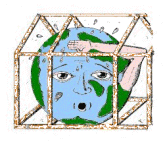|
Introduction to Global Warming
 Measurements of temperature taken by instruments all over the world, on land and at sea have revealed that during the 20th century the Earths surface and lowest part of the atmosphere warmed up on average by about 0.6C. During this period, man-made emissions of greenhouse gases, including carbon dioxide, methane and nitrous oxide have increased, largely as a result of the burning of fossil fuels for energy and transportation, and land use changes including deforestation for agriculture. In the last 20 years, concern has grown that these two phenomena are, at least in part, associated with each other. That is to say, global warming is now considered most probably to be due to the increases in greenhouse gas emissions and concurrent increases in atmospheric greenhouse gas concentrations, which have enhanced the Earth's natural greenhouse effect. Whilst other natural causes of climate change can cause global climate to change over similar periods of time, computer models demonstrate that in all probability there is a real discernible human influence on the global climate. Measurements of temperature taken by instruments all over the world, on land and at sea have revealed that during the 20th century the Earths surface and lowest part of the atmosphere warmed up on average by about 0.6C. During this period, man-made emissions of greenhouse gases, including carbon dioxide, methane and nitrous oxide have increased, largely as a result of the burning of fossil fuels for energy and transportation, and land use changes including deforestation for agriculture. In the last 20 years, concern has grown that these two phenomena are, at least in part, associated with each other. That is to say, global warming is now considered most probably to be due to the increases in greenhouse gas emissions and concurrent increases in atmospheric greenhouse gas concentrations, which have enhanced the Earth's natural greenhouse effect. Whilst other natural causes of climate change can cause global climate to change over similar periods of time, computer models demonstrate that in all probability there is a real discernible human influence on the global climate.
If the climate changes as current computer models have projected, global average surface temperature could be anywhere from 1.4 to 5.8C higher by the end of the 21st century than in 1990. To put this temperature change into context, the increase in global average surface temperature which brought the Earth out of the last major ice age 14,000 years ago was of the order of 4 to 5C. Such a rapid change in climate will probably be too great to allow many ecosystems to suitably adapt, and the rate of species extinction will most likely increase. In addition to impacts on wildlife and species biodiversity, human agriculture, forestry, water resources and health will all be affected. Such impacts will be related to changes in precipitation (rainfall and snowfall), sea level, and the frequency and intensity of extreme weather events, resulting from global warming. It is expected that the societies currently experiencing existing social, economic and climatic stresses will be both worst affected and least able to adapt. These will include many in the developing world, low-lying islands and coastal regions, and the urban poor.
The Framework Convention on Climate Change (1992) and the Kyoto Protocol (1997) represent the first steps taken by the international community to protect the Earth's climate from dangerous man-made interference. Currently, nations have agreed to reduce greenhouse gas emissions by an average of about 5% from 1990 levels by the period 2008 to 2012. The UK, through its Climate Change Programme, has committed itself to a 12.5% cut in greenhouse gas emissions. Additional commitments for further greenhouse gas emission reduction will need to be negotiated during the early part of the 21st century, if levels of greenhouse gas concentrations in the atmosphere are to be stabilised at reasonable levels. Existing and future targets can be achieved by embracing the concept of sustainable development - development today that does not compromise the development needs of future generations. In practical terms, this means using resources, particularly fossil-fuel-derived energy, more efficiently, re-using and recycling products where possible, and developing renewable forms of energy which are inexhaustible and do not pollute the atmosphere.
|

